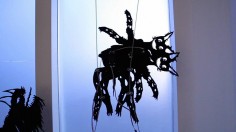MIKE PELLETIER
Майк Пеллетье
Toxoplasmosis
source: mikepelletiernl
This was a collaborative project with Geoffrey Lillemon for the window at Random Studio in Amsterdam. The main graphic inspiration for this project was Lotte Reiniger’s 1926’s film “The Adventures of Prince Achmed”. We wanted to create a physical, kinetic sculpture inspired by the strong graphic silhouettes found in her films. The sculptures were created from laser-cut plywood and we used custom dc and servo motor controllers to drive the animations.
For the window installation we used a LCD projector to rear-project on the window. This gave the psychedelic cats an animated backdrop for the silhouettes, as well the opportunity to add some extra animated effects to the silhouettes such as eye blinks. They coated the windows with lacquer to create the projection surface.
.
.
.
.
.
.
.
source: creativeapplicationsnet
Created by Mike Pelletier and Geoffrey Lillemon at Random Studio, Toxoplasmosis Window Installation was created to introduce an interesting experience for the people that pass by the studio on a daily basis. The team came up with an idea for a psychedelic cat puppet show which took place on the studio’s large store-front style street level windows, located on a scenic street along the Amstel river in Amsterdam.
The main graphic inspiration was Lotte Reiniger’s 1926’s film “The Adventures of Prince Achmed”. They wanted to create a physical, kinetic sculpture inspired by the strong graphic silhouettes found in her films. As a volunteer at Fablab Amsterdam Mike had access to many great tools and equipment, most importantly a laser cutter. They used 3mm plywood, which was lightweight, easy to laser cut, and still strong enough to make very detailed silhouettes.
They started by creating simple prototypes to test different mechanisms to make the characters move and see if the animation would work. They could quickly cut out the pieces on the laser cutter and then re-adjust them if they did not fit properly. These prototypes would act as a template and guide for the illustrations, which would be drawn over. They would work back and forth in an iterative process where they could quickly test and see if things worked both visually and technically and then make adjustments.
One of the techniques that they used was a modified version of Theo Jansen’s famous Strandbeest walker mechanism. They loved how strange and natural the movement of his walkers looked, and wondered how it would change when adapted from Jansen’s geometric look to Geoffrey Lillemon’s more chaotic and surreal style.
4 of the sculptures were powered by DC geared motors. They used an Arduino with a motor shield to control the speed and timing of the motors. 2 of the other sculptures were powered by pairs of servo motors, these were driven by a Pololu Mini Maestro servo driver. With both of these controllers they could have the software running on the controllers, without having to use a computer.
For the window installation they used a LCD projector to rear-project on the window. This gave them an animated backdrop for the silhouettes, as well the opportunity to add some extra animated effects to the silhouettes such as eye blinks. They coated the windows with lacquer to create the projection surface.
Credits:
Artist collaboration between Geoffrey Lillemon & Mike Pelletier
Laser cutting done at the FabLab
Production by Random Studio


